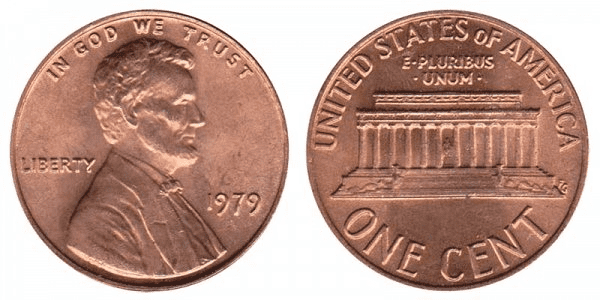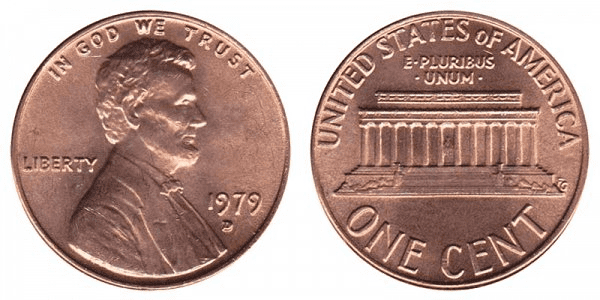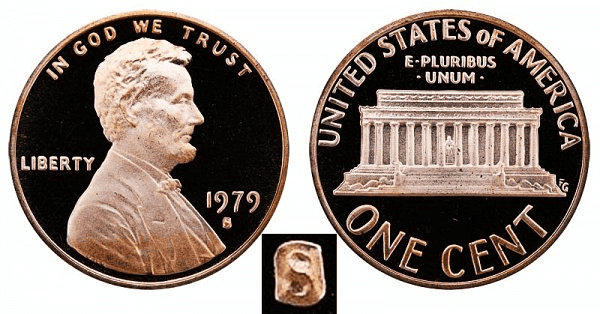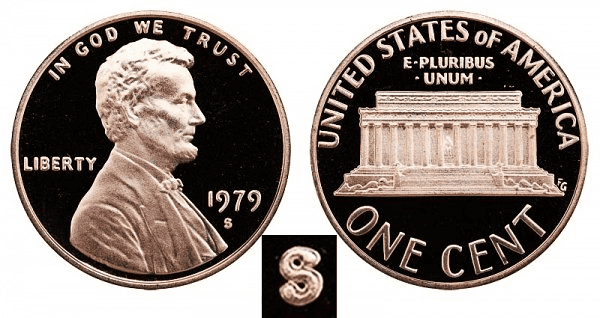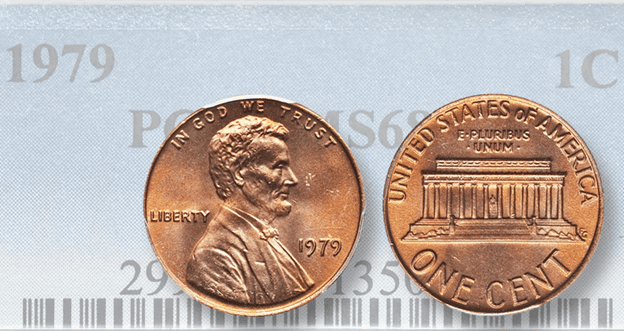What Is Special About The 1979 Lincoln Memorial Penny?
Although not all that common, the 1979 Lincoln Penny is frequently seen in change. The sentimental value of the 1979 penny determines its value, unless it’s a rare error coin.
One of the most fascinating characteristics of coins and coin collecting is its capacity to serve as a record of historical events that occurred in a specific year.
Additionally, they can be used as a keepsake for someone who was born that year or who experienced a significant life event during that year.
The commemorative 1979 Lincoln cent obverse, designed by Victor David Brenner to coincide with the president’s 100th birthday, is substantially identical to the 1909 version.
The main difference between the 1979 obverse and the 1909 edition is Brenner’s initials, V.D.B., which were transferred from the reverse in late 1909 and put beneath President Abraham Lincoln’s bust in 1918.
To Lincoln’s right is the year 1979, and above the president is the slogan “IN GOD WE TRUST.” To the president’s left, the word LIBERTY emerges.
The 1959 Lincoln Memorial reverse, created by Frank Gasparro, took the place of the 1909 Brenner wheat stalk design that can be seen on the 1979 cent. Gasparro’s initials, FG, can be seen on the lower right side of the Lincoln Memorial.
Under the structure and around the rim, the words “ONE CENT” are written, and the words “UNITED STATES OF AMERICA” are written around the upper part of the reverse along the rim.
Between the words, UNITED STATES OF AMERICA and the top of the Lincoln Memorial is written the motto E PLURIBUS UNUM. The edge of the Lincoln cent is plain or smooth without any engraving or reeding.
Prior to the introduction of a copper-plated zinc alloy in 1982, the Lincoln Cent was constructed of bronze and nickel.
The year 1979 saw the Three Mile Island nuclear accident and the Election of Margaret Thatcher. Also in this year, Trivial Pursuit was released, as was the Sony Walkman, and Pink Floyd’s infamous album ‘The Wall’.
1979 Penny Varieties
1979 P Penny (With No Mint Mark)
Year: 1979
Face Value: $0.01
Composition: 95% copper, 5% zinc
Weight: 3.11 grams (or over)
Diameter: 0.750 in. 19.05 mm
Thickness: 0.0598 inches (1.52 mm)
Edge: Plain
Minted in: Philadelphia
Mint Quantity: 6,018,515,000

photo source: www.usacoinbook.com
1979 D Penny
Year: 1979
Face Value: $0.01
Composition: 95% copper, 5% zinc
Weight: 3.11 grams (or over)
Diameter: 0.750 in. 19.05 mm
Thickness: 0.0598 inches (1.52 mm)
Edge: Plain
Minted in: Denver
Mint Quantity: 4,139,357,254

photo source: www.usacoinbook.com
1979 S Penny
Type 1 : Filled S
Year: 1979
Face Value: $0.01
Composition: 95% copper, 5% zinc
Weight: 3.11 grams (or over)
Diameter: 0.750 in. 19.05 mm
Thickness: 0.0598 inches (1.52 mm)
Edge: Plain
Minted in: San Francisco
Mint Quantity: 3,677,175

photo source: www.usacoinbook.com
Type 2 : Clear S
Year: 1979
Face Value: $0.01
Composition: 95% copper, 5% zinc
Weight: 3.11 grams (or over)
Diameter: 0.750 in. 19.05 mm
Thickness: 0.0598 inches (1.52 mm)
Edge: Plain
Minted in: San Francisco
Mint Quantity: Unknown

photo source: www.usacoinbook.com
Even when magnified five times, the “S” mintmark on a 1979-S Type 1 coin hardly resembles a “S” at all. It resembles a bouncy rectangle more than a “S.”
The U.S. Mint coiners changed the mintmark in late 1979 so that it resembled a “S” more. The 1979-S Type 2 is significantly more defined and resembles a “S” much more.
Compared to the 1979-S Type 2 proof cent, the 1979-S Type 1 proof penny is far more prevalent. However, there actually isn’t much of a price difference between the two sorts because there are plenty of each to meet the present collecting demand.
List of Errors
Doubled-Die Penny
You have to know what you’re looking for to find some 1979 doubled-die pennies that are worth a lot of money.
Keep in mind that not all doubles you encounter on coins are uncommon and expensive. Actually, the majority of the doubling you’re likely to see on antique coins is just machine doubling, which results from issues with how the coin was struck.
Coins that are doubled mechanically are not doubled dies. They are common items that are barely, if at all, worth more than their standard prices.
On 1979 pennies, seek for doubling in the inscription, date, bowtie, face, and ear details on the obverse to identify valuable duplicated dies. Look for doubling in the Lincoln Memorial’s letters or columns on the back (“tails side”).
There are no known 1979 doubled die coins with extremely dramatic doubling; there are also none comparable to the 1955 or even 1972 doubled die pennies. 1979 doubled die pennies, however, can exchange for $20 to $50 each or even more!
1979 ‘BIE’ Penny
When a die that is punching a design onto blank coins starts to exhibit indications of wear through cracking, it might make an error called a “die break.” These fissures may appear as a raised line, squiggle, bump, or lump on the struck coin.
There is a specific form of die crack that only appears on Lincoln pennies. The BIE variation is distinguished by a thin, vertical raised line that can be seen between the letters “B” and “E” of the word “LIBERTY” on the coin’s obverse. This little line approximately resembles the capital letter “I,” which contributes to the variety’s “BIE” moniker.
Although BIE pennies are rather common, some Lincoln penny collectors aim to collect them by date since they make fantastic collections. The value of a 1979 BIE cent in average worn condition ranges from $5 to $10.
1979 Penny With a Repunched Mint Mark
The U.S. Mint was still manually punching mintmarks into the working dies in the late 1970s, which left room for a lot of mistakes to occur.
These minor accidents frequently produced slightly off mintmarks and other minute but obvious flaws. Coiners would attempt to repair these errors by repunching the mintmark, but this didn’t always eliminate the first (incorrect) mintmark punch.
Depending on how severe the fault is, 1979 pennies with repunched mintmarks have a range of values, although the ordinary variety of this kind is worth $3 to $10.
Are There Any Rare 1979 Pennies?
1979 Lincoln cent, PCGS Mint State 68 Red

photo source: www.coinworld.com
The fact that a 1979 Lincoln cent, with a mintage of little over 6 billion, may be worth hundreds of dollars is difficult for the average individual to comprehend.
However, individuals who appreciate gathering the best examples for their registry sets can comprehend why even ordinary coins can fetch high sums in top grades.
Heritage sold a 1979 Lincoln cent graded Mint State 68 red by PCGS for a hefty $2,820 at its Long Beach auctions in September 2016.
Why Is A 1979-S Penny Worth So Much?
‘S’ Marked coins tend to be worth a little more than those minted in Philadelphia or Denver, because the San Francisco mint was chiefly in charge of creating ‘proof’ coins, which are those designed for collectors.
For a typical example, the 1979-S Type 1 and Type 2 pennies trade for between $5 and $10 each.
The most expensive 1979-S Type 2 proof penny sold for $3,819, while the 1979-S Type 1 proof penny set a record price of $10,925. Remember that the 1979-S proof pennies won’t likely be in your pocket change because the U.S. Mint didn’t put them into circulation.
How Much Is A 1979 Penny Worth Today?
Because copper has increased so much in value, all Lincoln Memorial pennies produced before to 1982 (the year the United States Mint started producing these pieces in a less expensive copper-plated-zinc version) are now worth more than their face value.
Because the value of the copper inside the coin was expected to rise above the coin’s nominal value of “ONE CENT,” the Mint swapped metals in the early 1980s.
Therefore, the copper value of a 1979 penny alone is worth 2 to 3 cents. However, some are still worth a lot more!
For instance, uncirculated 1979 pennies without a mintmark are typically valued at 10 to 30 cents each, such as those that are brand new off the bankroll and have never been used as money. In a 2012 auction, the most expensive 1979 penny without a mintmark brought in $5,463!
A worn (circulated), average 1979-D penny is worth between two and three cents. Uncirculated examples often cost between 10 and 30 cents. In 2016, the most expensive 1979-D penny sold for $3,995.
How Does The Grading System Work?
The Sheldon Scale is used by numismatists to provide a numerical value to coins. The Sheldon Scale goes from poor (P-1) to perfect mint state (P-1) (MS-70). Coins were originally evaluated using words to reflect their condition (Good, Fair, Excellent, Etc.). Unfortunately, coin collectors and dealers had different ideas about what each of these terms represent.
Professional numismatists joined together in the 1970s and established CoinGrading standards. These numismatists now assign grades at key places on the seventy-point scale, using the most regularly utilized numeric points in conjunction with the original adjective grade. The following are the most common coin grades:
-
-
- (P-1) Poor – Indistinguishable and probably damaged; if used, must have a date and mintmark; otherwise, rather battered.
- (FR-2) Fair – Nearly smooth, but without the damage that a coin graded Poor often possesses. The coin must have enough detail to be identified.
- (G-4) Fair – Inscriptions have merged into the rims in some areas, and important elements have been mostly erased.
- (VG-8) Very Good- A little weathered, but all of the primary design elements are visible, albeit faintly. There is little if any, central detail left.
- (F-12) Good – The item is very worn, yet the wear is even, and the overall design details stand out clearly. Rims are almost completely isolated from the field.
- (VF-20) Very Fine – Moderately weathered, with some finer features still visible. The motto or all letters of LIBERTY are readable. Both sides of the coin have entire rims that are separated from the field.
- (EF-40) Extremely Fine – Gently used; all gadgets are visible, and the most important ones are bold. The finer details are bold and clear, however, light wear may be seen.
- (AU-50) Uncirculated – Slight evidence of wear on the coin’s design’s high points; may have contact marks; eye appeal should be adequate.
- (AU-58) Uncirculated Choice – Slight traces of wear, no severe contact marks, almost full mint shine, and great eye appeal.
- (MS-60) Mint State Basal – Strictly uncirculated; no indication of wear on the coin’s highest points, but an unsightly coin with reduced luster, visible contact marks, hairlines, and other flaws.
- (MS-63) Mint State Acceptable – Uncirculated, but with contact scratches and nicks, little reduced shine, but otherwise appealing appearance. The strike is weak to average.
- (MS-65) Mint State Choice – Uncirculated with great mint shine, very little contact blemishes, and exceptional eye appeal. The strike is unusually severe.
- (MS-68) Mint State Premium Quality – Uncirculated with superb luster, no obvious contact marks to the naked eye, and exceptional eye appeal. The strike is quick and appealing.
- (MS-69) Almost Perfect Mint State – Uncirculated with perfect brilliance, a sharp and appealing strike, and extremely good eye appeal. A near-perfect coin with minor imperfections in the planchet, strike, and contact markings (seen only under 8x magnification).
- (MS-70) Mint State Perfect – Under 8x magnification, there are no tiny imperfections discernible; the strike is crisp, and the coin is perfectly centered on a beautiful planchet. Rarely seen on a coin, this coin is bright and whole, with original luster and exceptional eye appeal.
-
Where To Buy Or Sell 1979 Pennies?
Flea markets, estate sales, and online marketplaces like eBay are the ideal places to get 1979 Pennies because they are primarily regarded as novelty or sentimental coins for those who were born in the year, got married in the year, or had other significant events occur in the year.
Working with trustworthy coin dealers and auction houses like Heritage Auctions is essential when dealing with odd or rare coins, such as the 1979 Pennies with faults or those of exceptional condition, for added peace of mind.
You may always ask for advice in coin collecting forums if you’re unsure whether or not your penny has a more valuable mint defect.
FAQs
What is the highest price ever paid for a 1979-S Type 1 proof penny?
The 1979-S Type 1 proof penny set a record price of $10,925 at auction.
Is 1979 Canadian penny worth anything?
The quality and wear, supply and demand, rarity, finish, and other elements all affect a Canadian coin’s worth. A 1979 one-cent coin has a melt value of $0.04 CAD.
Where is the mint mark on a 1979 penny?
The mint mark on 1979 pennies is found on the obverse side of the coin next to Lincoln’s chest and below the date.
How much is the most valuable 1979 – D penny?
In 2016, the most expensive 1979-D penny sold for $3,995.

